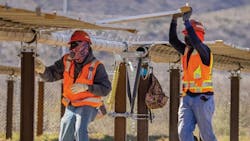Quanta CEO: Energy Transition Investments Need ‘More Collaborative Environment’
Federal and state energy agencies should be more collaborative and strategic in their decisions to help the United States avoid serious stumbles during the energy transition, the CEO of infrastructure services provider Quanta Services Inc. told investors June 1.
Speaking at a conference hosted by research firm Bernstein, Quanta President and CEO Earl ‘Duke’ Austin Jr. said he’d like to see a broad long-term plan that helps utilities make the shift from today’s energy system to a carbon-free environment in which electric vehicles are a major consumer of power. A shortfall of such long-term thinking, he said, is the biggest bottleneck facing the sector.
“Federal policy and state policy [are] disconnected a bit from the standpoint of how we’re pushing incentives for builds,” Austin said. “There needs to be a more collaborative environment [for] everything from permitting down to funding.”
With utilities and other companies planning to spend hundreds of billions of dollars to expand and strengthen their networks—PG&E Corp., a Quanta customer, last week sketched out a plan that would have invest an average of $13 billion annually from 2028 to 2032 in California—rate payers across the country are being asked to fund a wide range of projects. But Austin said companies and regulators can do a better job communicating how rate payers’ money translates into improvements.
“The regulator is going to be concerned about what does [a large capital spending plan] do to the bill -- that day, that year -- instead of looking at this more in a long-term nature,” he said. “I think those hangups will be out there and you’ll see some political strife on that.”
Quanta, which in late 2021 acquired Blattner Holding Co., stands to be a big beneficiary of energy and other infrastructure investments for years to come: Austin and CFO Derrick Jensen last year said organic growth alone stood to add $9 billion to the company’s top line by 2027 and Austin on June 1 said his team has the chance to grow profits per share at more than 15% per year in the near future. But he also noted that strains are already showing in the grid’s ability to handle the mass adoption of EVs, pointing to several days last year when some drivers were asked not to charge their cars.
Parts of the infrastructure equipment supply chain also still need to improve, Austin added, although he’s optimistic that will happen in the coming year. But poles and transformers remain a problem, with wait times still regularly reaching two years. (See also: ‘No Easy Answers: Transformer Supply Crisis Deepens’ from February.)
“It’s not terrible but it’s still an issue,” Austin said. “If you’re a smaller utility or smaller developer trying to build, it’s very difficult.”
Shares of Quanta (Ticker: PWR) were changing hands at nearly $180 on June, up more than 2% on the day. Over the past six months, they have climbed more than 15%, growing the company’s market capitalization to more than $26 billion.
About the Author
Geert De Lombaerde
Senior Editor
A native of Belgium, Geert De Lombaerde has more than two decades of business journalism experience and writes about markets and economic trends for Endeavor Business Media publications T&D World, Healthcare Innovation, IndustryWeek, FleetOwner and Oil & Gas Journal. With a degree in journalism from the University of Missouri, he began his reporting career at the Business Courier in Cincinnati and later was managing editor and editor of the Nashville Business Journal. Most recently, he oversaw the online and print products of the Nashville Post and reported primarily on Middle Tennessee’s finance sector as well as many of its publicly traded companies.
